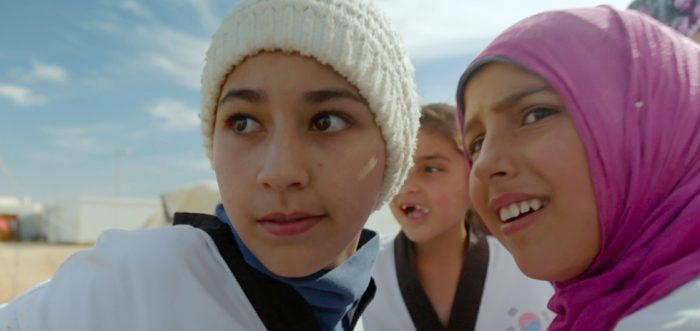
When your film centres on one of the key points in deciding, among many things, the next American president, chances are it will come under a lot of scrutiny. Yet Steph Ching and Ellen Martinez bring the high-profile media status of the Syrian refugee crisis itself into question with their documentary After Spring which emphasizes the everyday routines of families and volunteers in the Jordanian camp of Zaatari over more political activities. The film is really about the struggle of the the 80,000 residents and workers in Zaatari to maintain normal lives and even regimens that they’ve built atop states of displacement and poverty. It’s a film that wants to suggest a more complex and less exploitative portrayal of the issue than images of distressed crowds at fenced national borders, bus stations and harbors. As a statement in and of itself, then, After Spring takes a step in the right direction of addressing a popular public conception of a crisis. Its own image, on the other hand, is what’s in question here, and it unfortunately makes several too many broad strokes to contribute the more cohesive or constructive statement that it itself necessitates.
After Spring follows several refugee families and volunteer workers. It’s a nonfiction ensemble piece that aims for slice-of-life, which may be part of why it feels like a mess, both in terms of structure and pacing. Ideally, we would cut back and forth between groups and individuals as they face day-to-day struggles, try to maintain a sense of order in their lives or in the community, and reveal along the way their own inner conflicts and states of mind in the process. Instead, the film keeps many of its subjects at a distance, as though it can hardly keep track of any of them. Talking heads, mostly managers or family patriarchs, speak unconvincingly for others, who very rarely have their say. The film transitions shakily from scene to scene with melanges of outdoor bustle at makeshift markets and water fountains. Statistical intertitles and series of Tweets by tourists and celebrities only further serve to remind us that this is a documentary of the humanitarian PSA subgenre.
And yet there is a collection of fleeting moments that can be quietly observed and intimate, tense and distressing, or even inspiring. When talking heads are out of the way, we witness children playing in their bare portable homes, or the men watching TV and pointing out various militant groups on the news. We follow volunteers as they drive hours between Zaatari and their homes in Jordan, organize and regulate the distribution of limited supplies that were donated, and make split-second decisions that they know will have immediate consequences. Tangentially connected to all of this yet given equal weight is a friendly taekwondo instructor, who runs a martial arts program in the camp that instructs eager youths in both physical and mental disciplines as a means of forming camaraderie, leadership and hope among the next generation. This array of characters is successfully established and serves to represent the majority of camp life and the narrative. Through them our attention is brought to various issues, from unregistered squatters, housing shortages, overcrowding in classrooms, access to news of the outside world, family and friends that are either stuck in Syria or fighting in the civil war, to the fact that children are conceived and born every day within the camp grounds as more continue to enter from outside. What connects all of this is an alternately sad and joyous look towards an uncertain future and an attempt to recreate what might have been.
It’s unfortunate that this is obfuscated and scattered by a tedium of images and unanswered questions that try and fail to represent the camp as a whole. Rather than connecting and further illustrating the nuances of refugee life that After Spring’s individual subjects purvey, it diverts attention away from them. It is once again repetitive imagery and far-too similar voices that result from severe limitations of what and how Ching and Martinez are able to film, and their failure to address this in turn leaves a grossly unnecessary amount to the imagination. The most prominent of these restrictions is that we only get to see inside Zaatari during the daytime, the only exceptions being wide landscape shots of the camp from afar at dusk or when the filmmakers are hosted indoors by a refugee family for the night. Another is seeing tank-like supply carts as big as houses being wheeled and pushed down streets of dirt or mud, sometimes by adult men but more often by young boys who refuse to attend the crowded schools. All of this is rife with potential for what many more issues it represents in the community—crime, curfews, policing, education, the general well-being of youth—but in its present state it is a failed attempt to create atmosphere and instead clogs whatever clarity that Ching and Martinez managed to develop.
After Spring simply reaches for the stars, and that is its own contradiction and downfall. As a film about the vast uncertainty for a small, yet crowded, makeshift city, it’s just too optimistic in the end, even when it considers one of its subjects’ protest: “nothing is happening on the ground, as if that’s the way the world wants it.” In this world of sensationalism and partisanship, could we find something more neutral, sober, and self-aware?
